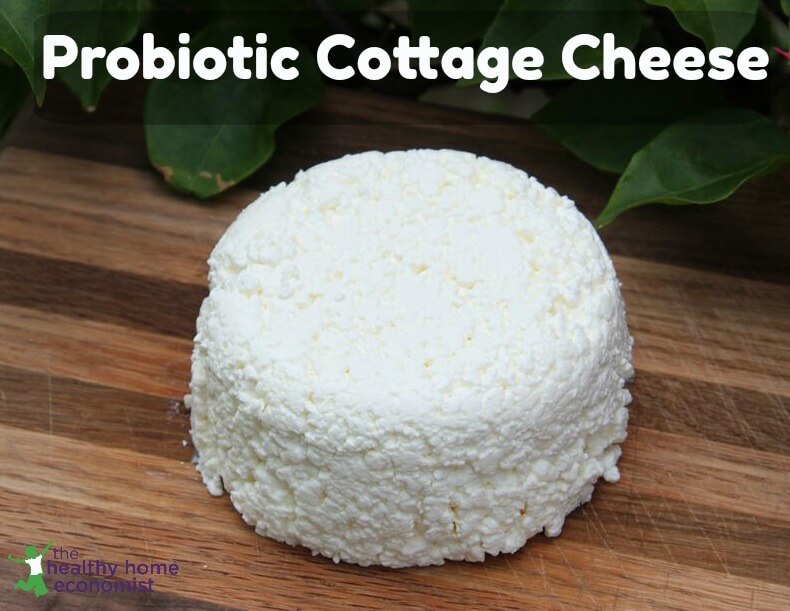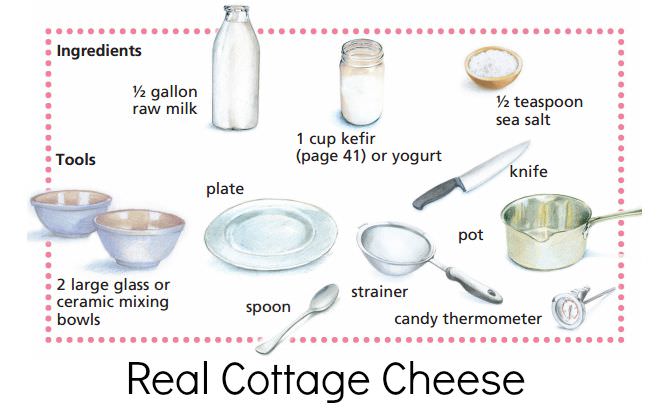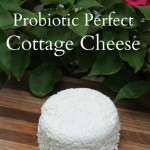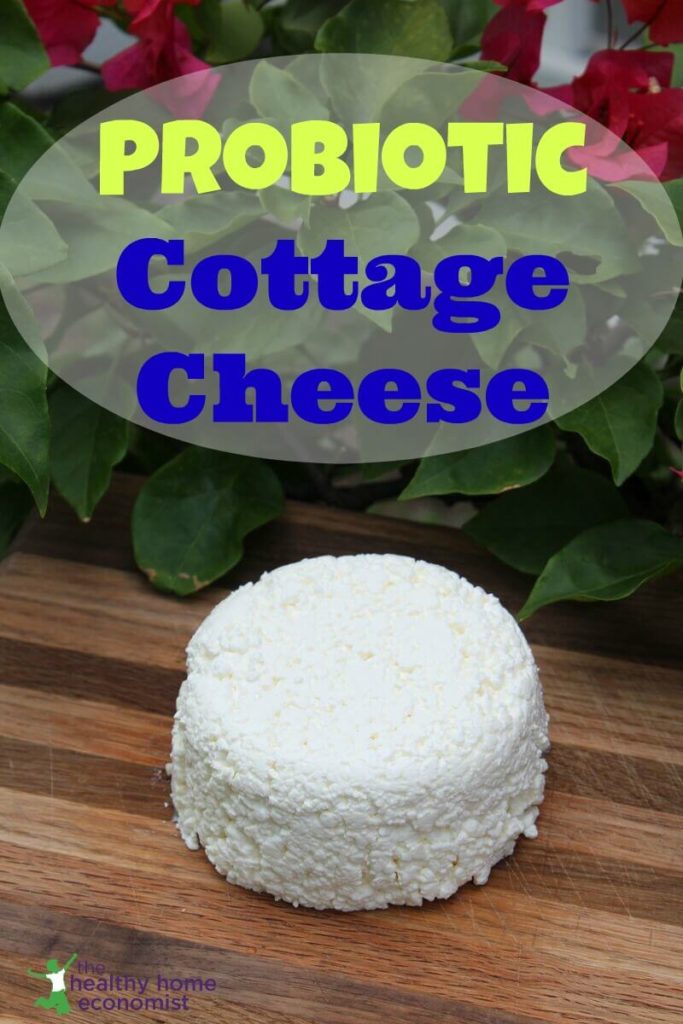Easy recipe for full fat cottage cheese with probiotics and enzymes intact which is virtually impossible to find at supermarkets or healthfood stores.

In the Western world, cottage cheese is nearly synonymous with dieting and all things related to the pursuit of skinny.
Cottage cheese is typically served with sliced fruit on top as an ultra low-calorie meal. It’s been the poster child for losing weight since the lowfat dogma of the 1960s took hold and escorted Westerners down a path to even greater weight and health challenges.
Unfortunately, the madness continues in conventional circles to this day. The American Heart Association recently blasted coconut oil as heart unhealthy. Seriously?
Why then did ancestral cultures that ate LOTS of it suffer virtually no heart disease? No wonder an increasing number of people don’t pay any attention and choose to do their own research.
While cottage cheese is certainly a nutritious, traditional food (Little Miss Muffet was probably eating something similar while sitting on her tuffet), it has, in the modern sense, seriously lost its way.
Supermarket and even organic health food store cottage cheese is highly processed and lowfat. Such concoctions are more likely to trigger binge eating than satisfy and proactively assist with sustainable weight loss goals.
This is because the skim milk from which the cottage cheese is made, organic or not, has had all the nutrient-dense cream removed. Worse, it has been pasteurized at high temperatures destroying much of the nutrition (Vitamins C and E, B12, B1, B2, folate). Digestive enzymes and beneficial microbes known as probiotics are obliterated as well.
And, as anyone who truly understands nutrition knows, skim milk and anything made with it encourages weight gain much more readily than helps you lose weight! Just ask any pastured pig farmer – skim milk is a key tool to get the pigs really fat!
Sourcing Truly Healthy Cottage Cheese
Finding probiotic and enzyme-rich, full fat cottage cheese is very difficult if not impossible depending on where you live. If you’re lucky enough to source locally, chances are it will be from a small grassfed dairy.
As a result, if you’re a cottage cheese lover like I am, it’s best to learn how to make it yourself. Fortunately, the process of making truly traditional cheese of the modern cottage variety is simple.
And, when you handcraft and consume curds and whey in this manner, it really will help you with your weight loss goals because, in a word, it will truly satisfy!
Probiotic, Enzyme Rich and Full Fat
The best recipe for full fat, raw cottage cheese (newsflash: the way it’s supposed to be) that I’ve seen is actually illustrated in The Nourishing Traditions Cookbook for Children.
That’s right, healthy cottage cheese is so simple to make a child can actually do it!
If you want to teach your children the basics of traditional cooking, this lovely little cookbook is a must-have. It’s spiral bound for easy page flipping by little hands and contains ingredient illustrations instead of hard to follow ingredient lists.
My daughter and I have been poring through it this summer to expand her culinary knowledge. I highly recommend it for anyone with children 10 and under.
Homemade Cottage Cheese
Many thanks to author Sally Fallon Morell for generously allowing the sharing of this recipe and ingredient illustration from The Nourishing Traditions Cookbook for Children.
Equipment Needed
The image below shows the equipment and ingredients you will need to get started making the homemade cottage cheese recipe.


Cottage Cheese Recipe
Easy recipe for full fat cottage cheese with probiotics and enzymes intact which is virtually impossible to find at supermarkets or healthfood stores.
Ingredients
Instructions
-
Pour the milk into a large mixing bowl (I use these glass bowls). Cover the bowl with a plate and leave it in the refrigerator until all the cream rises to the top. This might take up to 24 hours.
-
Skim off the cream with a spoon or easier still, a stainless steel turkey baster, and save it in a pint sized glass mason jar or similar container in the refrigerator (hint: you will use it later!).
-
Mix the kefir or yogurt into the milk with a spoon. Cover the bowl with a plate once more and leave on the counter at room temperature until the milk thickens like yogurt. This is what is called the curd and it will take 1-2 days depending on your home’s temperature and the freshness of the raw milk.
-
Using a knife, cut the curd in the bowl into tiny squares by slicing through it from top to bottom and left to right. Try to keep the cuts no larger than 1/4 – 1/2 inch (.64 cm – 1.3 cm) apart.
-
Fill a medium sized pot with filtered water about 1 inch deep. Put the pot on the stovetop with the burner set to low heat. Place the bowl of curds with the plate removed on top.
-
Test the temperature of the curds every 5 minutes with a digital food thermometer. After each 5 minute check, stir the curds for a few seconds. Continue with this process for about 30 minutes (6 – 5 minute checks) until the curds reach 110 F/43 C. All enzymes and probiotics will be preserved if you only heat to this low temperature. How to know? If you stick your finger in and don't get burned, no destruction of beneficial microbes or enzymes has occurred. This would happen if you heat the milk higher than 117 F/47 C, which is why it is so important to keep checking the cottage cheese every 5 minutes to ensure that the temperature doesn't get too high.
-
Remove the bowl from the heat when the desired temperature has been reached and separate the curds from the whey with a strainer set inside a mixing bowl. The curds will stay in the strainer and the liquid whey will run into the bowl underneath.
-
Rinse the curds still inside the strainer with cold, filtered water. Be sure to very gently stir the curds with a spoon until all the water drains out.
-
Put the curds in a container and mix with the sea salt and reserved cream you have in the refrigerator. You now have raw, full fat cottage cheese with all the beneficial probiotics, vitamins and enzymes from the raw milk still intact! Cottage cheese is delicious freshly made, but be sure to refrigerate any leftovers. In my experience, this truly traditional cottage cheese lasts for several weeks in the refrigerator.
Recipe Notes
Full fat yogurt may be substituted for the kefir. These yogurt brands are best.
More Information on Healthy Cheese
If learning to make cheese is exciting to you, check out my other cheesemaking posts here:









Do you use milk kefir or water kefir?
If you click on the kefir ingredient in the recipe, it will take you to a milk kefir recipe.
Hi!! How can I make this recipe using fresh (but pasteurized) store bought milk)?
You need raw milk to make this specific version of cottage cheese. Store milk is too overly processed for the recipe to work.
This was a nice change from trying the old way (the way my husband says his grandma did it). It tastes good! I really enjoy it and am happy that the probiotics and enzymes are still active up to 110 degrees (which is actually the recommended temp for culturing yogurt, if anyone is concerned). If I could change anything, I would like it a little sweeter and a little firmer. I used a pack of sweet yogurt starter (for 1-2 quarts) and let it set for almost 48 hours at room temp (around 78F during the day). It was a soft curd at this point. Is there any way to make a little firmer curd? Will heating longer than 30 minutes (under 110, of course) help it to be a little more firm? And, lastly, is it less tangy (and more like store-bought cottage cheese) if kefir is used instead of yogurt? Thanks for the how to!
Turned out great! What can be done with the leftover whey?
Gjetost cheese is a good one. https://www.thehealthyhomeeconomist.com/drowning-in-whey-make-gjetost-cheese/
Sorry this was asked before but I didn’t see an answer. As the other poster said, unfortunately it’s almost impossible to get raw milk (goat or cow). Even driving 100 miles to the closest “allowed” provider, they are only allowed to make a small amount so it’s almost always gone before I get there. I know P milk isn’t as healthy but will it actually turn into cottage cheese if sub’d in this recipe?
Thanks for sharing this. I’m paying premium for the only probiotic cottage cheese in the store, and I’d love to make my own.
Have you checked realmilk.com?
Once you hit the fear, you kill the enzymes. It is no longer a fermented product.
Me too!